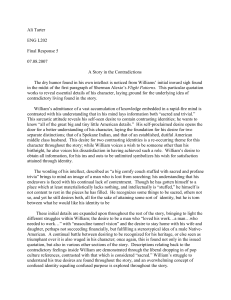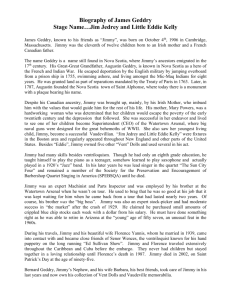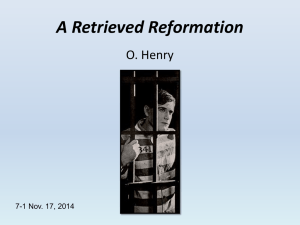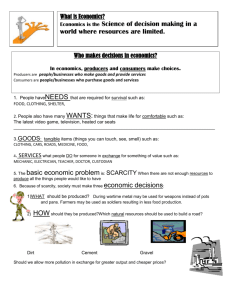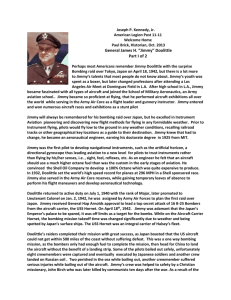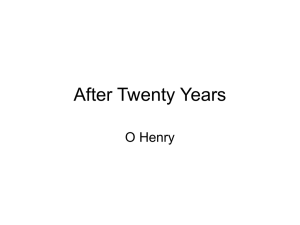When the War Came Home
advertisement
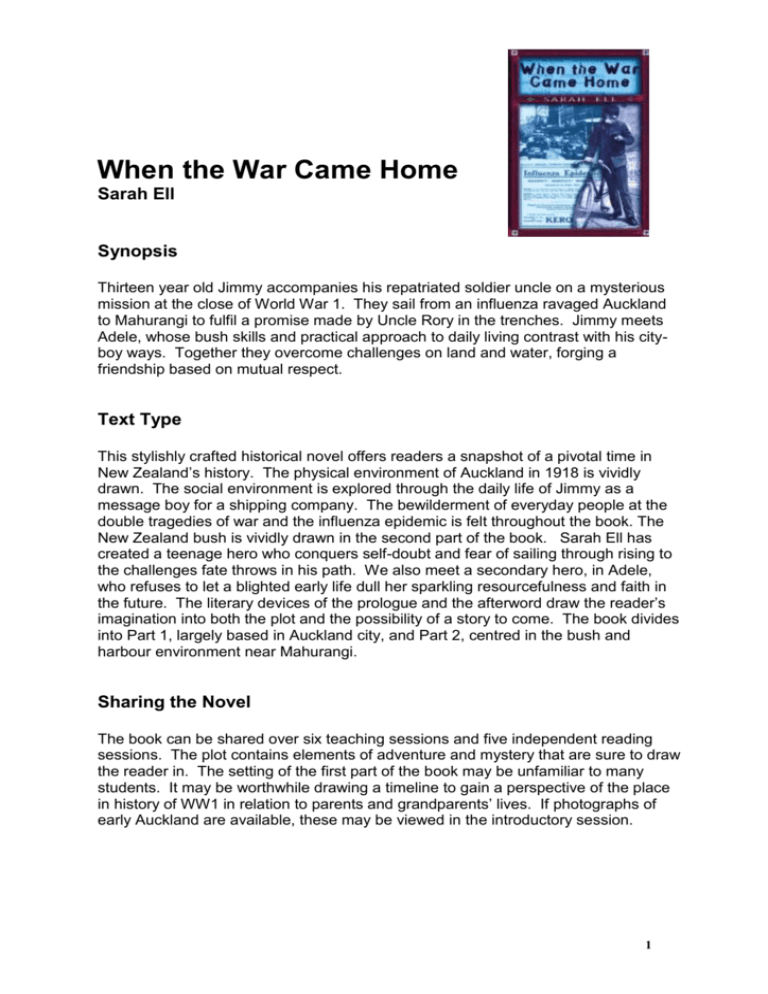
When the War Came Home Sarah Ell Synopsis Thirteen year old Jimmy accompanies his repatriated soldier uncle on a mysterious mission at the close of World War 1. They sail from an influenza ravaged Auckland to Mahurangi to fulfil a promise made by Uncle Rory in the trenches. Jimmy meets Adele, whose bush skills and practical approach to daily living contrast with his cityboy ways. Together they overcome challenges on land and water, forging a friendship based on mutual respect. Text Type This stylishly crafted historical novel offers readers a snapshot of a pivotal time in New Zealand’s history. The physical environment of Auckland in 1918 is vividly drawn. The social environment is explored through the daily life of Jimmy as a message boy for a shipping company. The bewilderment of everyday people at the double tragedies of war and the influenza epidemic is felt throughout the book. The New Zealand bush is vividly drawn in the second part of the book. Sarah Ell has created a teenage hero who conquers self-doubt and fear of sailing through rising to the challenges fate throws in his path. We also meet a secondary hero, in Adele, who refuses to let a blighted early life dull her sparkling resourcefulness and faith in the future. The literary devices of the prologue and the afterword draw the reader’s imagination into both the plot and the possibility of a story to come. The book divides into Part 1, largely based in Auckland city, and Part 2, centred in the bush and harbour environment near Mahurangi. Sharing the Novel The book can be shared over six teaching sessions and five independent reading sessions. The plot contains elements of adventure and mystery that are sure to draw the reader in. The setting of the first part of the book may be unfamiliar to many students. It may be worthwhile drawing a timeline to gain a perspective of the place in history of WW1 in relation to parents and grandparents’ lives. If photographs of early Auckland are available, these may be viewed in the introductory session. 1 Introductory Session View the cover illustration. Predict something about the daily life of the central character. Predict something about the street scene. Discuss the typeface of the title. Note other aspects of the visual language of the cover design. Read the blurb and distinguish between the three blocks of text. Predict the significance of the book’s title. View the map at the start of the book. Comment on the style of the cartography. Comment on known place names. Estimate possible travelling times between some of the places on the map, then and now. What does the map suggest about the plot of this story? Discuss the fact that Sarah Ell is a new author. Think of other books you have read with an historical New Zealand setting. Teacher reads the prologue of When the War Came Home to introduce the story. Students read Chapters 1 – 6 (p11-52) independently before the next shared session. Comprehension / Discussion – Chapters 1- 6 Knowledge What do we know about Jimmy’s physical appearance? What is Jimmy’s job? Comprehension Why did Jimmy often travel around the city on foot? Why did Jimmy feel uneasy when he reached the suburb of Newton? Application If Mr Jones, the despatch clerk, had given Jimmy instructions for this job in writing, what might they have been? Make separate lists of adjectives to describe Uncle Rory, Bob and Jimmy. Do they have some characteristics in common? Analysis Can you compare Jimmy’s job with that of a courier driver today? Comprehension Why did Jimmy hesitate to rush out onto the street when news that the war had ended came? Evaluation Do you think Jimmy was fortunate or unfortunate in having to leave school at twelve or thirteen? Students read Chapters 7 - 12 (pp 53-88) before the next shared session. 2 Comprehension / Discussion – Chapters 7 – 12 Knowledge What were some of the ways that people showed their emotions on the streets at the news that the war had ended? Comprehension Can you explain what was running through Jimmy’s mind as he watched the train carrying coffins go by? Why did Jimmy momentarily mistake Uncle Rory for his missing father? Why did Jimmy feel less than enthusiastic about sailing to the destination out of Auckland with Uncle Rory? Application What questions would you ask Uncle Rory before you set off on the journey out of Auckland? Analysis How is the way news travels through a community different now from in 1918? What was the significance of the name of the yacht for Uncle Rory? Synthesis What would happen if Jimmy refused to go on the journey with his uncle? Evaluation What do you think about Jimmy’s uncertainty about taking the boat surreptitiously from the boatshed? Students read Chapters 13 - 19 (pp 91-129) before the next shared session. Comprehension / Discussion – Chapters 13 – 19 Knowledge What did jimmy find in the small bag that his uncle seemed very protective about? What were some of the birds that Jimmy saw as they arrived at Deans’ Landing? Comprehension How do you think Uncle Rory’s back became so scarred? Why did Adele question Jimmy closely about the berries he’d eaten? (Comprehension) Application Can you think of another story where people arrive at a deserted dwelling? Analysis What evidence is there that the house has been recently occupied? What are Jimmy’s feelings about living in the country? What do you think Jimmy’s mother meant by her statement that Uncle Rory had been completely changed by the war? Evaluation What do you think about Uncle Rory’s insistence that they sleep on the verandah? Jimmy believed the Germans to be the most evil people on earth. Can you defend his opinions? Synthesis What might happen if the owners of the house return home? Students read Chapters 20 - 26 (pp 130-172) before the next shared session. 3 Comprehension / Discussion – Chapters 20 – 26 Knowledge What did Jimmy learn about Adele’s family? What was the method of catching eels that Adele taught Jimmy? How did Adele finally kill the large eel? Comprehension What fears did Jimmy have when he fell into the pool? Why did Adele reveal her true name to Jimmy after the discovery at the graveyards? Why did Adele think that Rosemary Dean was no longer alive? Synthesis Can you devise another way for catching eels, using only materials that would have been available to Adele and Jimmy? Application Do you know of another story where circumstances result in the characters being thrown on their own resources for survival? Analysis What are some of the problems of being completely reliant on the local environment for your food? Evaluation Do you think it was justified for Adele to read Rosemary’s diary? Students read Chapters 27 - 32 and the Afterword (pp 173-205) before the next shared session. Comprehension / Discussion - Chapters 27 – 32 Knowledge What did Adele send Jimmy to find in the bush after Uncle Rory became sick? What were the values that Jimmy’s father had taught him as a boy? What skill did Jimmy lack when it was time to get on board the yacht for the return journey to Auckland? Comprehension Why did Jimmy find himself summoning up memories of his father when he found himself facing difficult decisions? Can you explain why Jimmy let Adele take charge of the launching of the yacht? Can you describe how the feelings of Adele and Jimmy changed as they discovered dolphins were swimming alongside the yacht? Application Do you know of another novel where the life of a person depended on the initiative and courage of the central characters? Analysis How do you think the seafarers’ belief that dolphins represent good luck may have arisen? 4 Evaluation Do you think Adele did the right thing in making a run for it when they arrived in Freeman’s Bay? Do you think an Afterword is an effective way to conclude a novel? Responses to Text Activities Write a letter. Write the reply that Adele could have written to Jimmy in March 1919, or at a later date. Make a list of bush skills. List the things that Adele taught Jimmy about feeding yourself and keeping safe in the bush. Write a newspaper report. Imagine you write for the New Zealand Herald in 1918. Report on the Te Wairua’s arrival at Freeman’s Bay. Make a model. Make a model of the Te Wairua or the house at Mahurangi. Design a book cover. Design either an alternative cover for this novel, or a cover for its sequel. Research history. Find out more about how people lived at the time of this story. Survey your class. Find out how many students in your class can name a novel in the historical fiction category lately. Write a list of instructions. Imagine you are Jimmy. You feel more confident now about sailing. You decide to write a list of instructions on how to launch and sail Te Wairua for teaching your younger sisters and brothers in the future. Write a poem. Imagine you are Jimmy’s Dad. You have been spending time on the long voyage home to New Zealand writing poems about your feelings about the war and your return home. Make a diorama. Choose one scene in the story and portray it as a diorama. Create a poster. A poster is required to promote this novel at a bookfair. Design one that communicates the setting and theme of the novel. Write and perform a play. Choose a part of the novel on which to base a short play. Try to give the dialogue flavour of the speech of the time. Levels of questioning based on Bloom’s taxonomy of cognitive processes Teacher notes: Christine Pettengill Edited by: Sally Weeds 5


